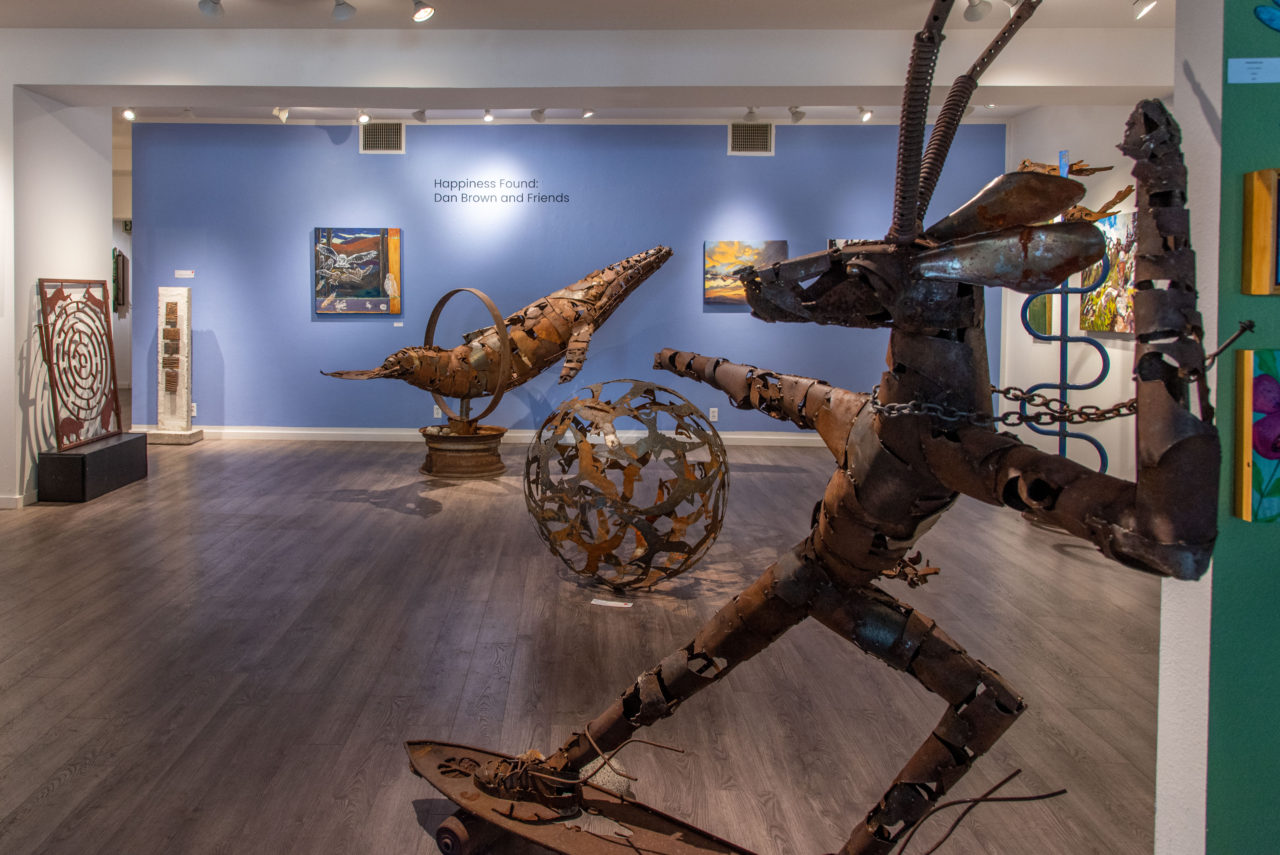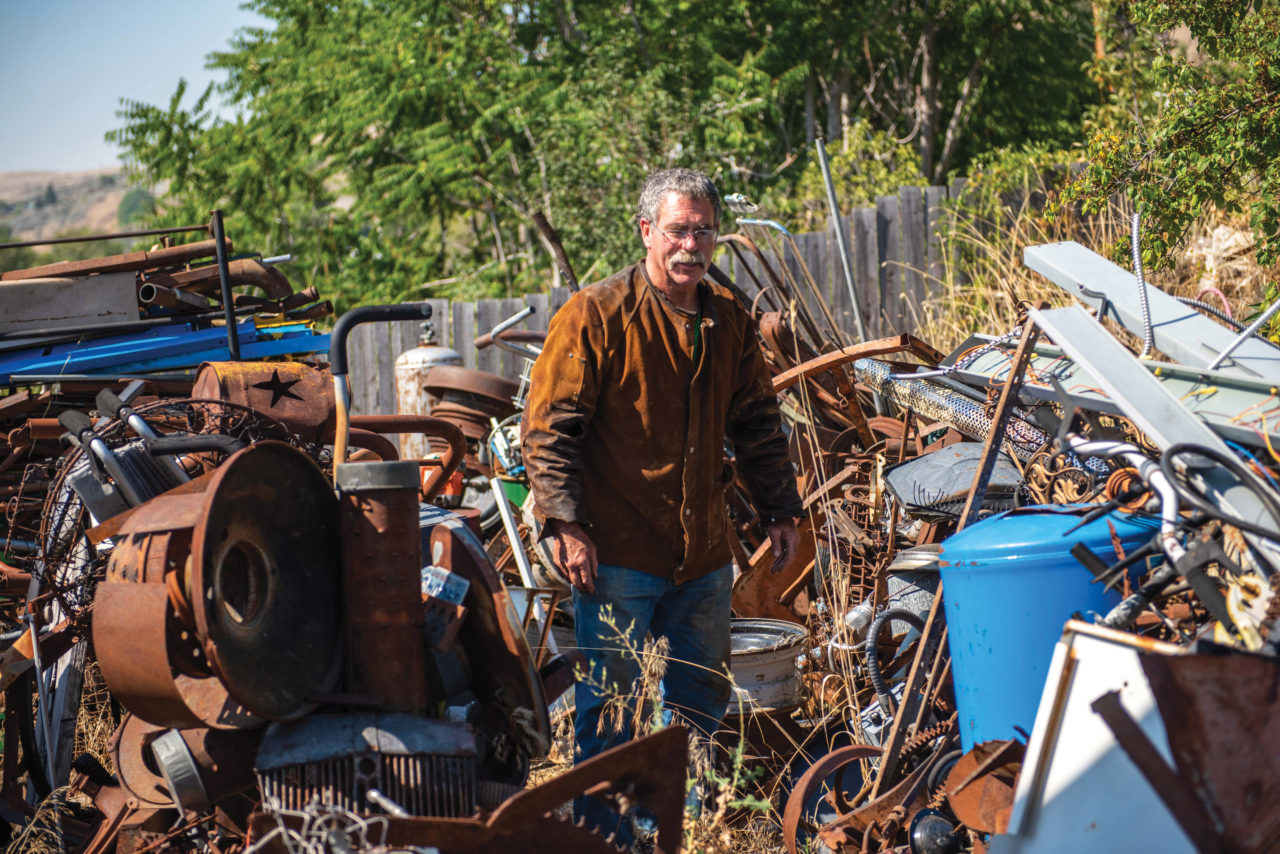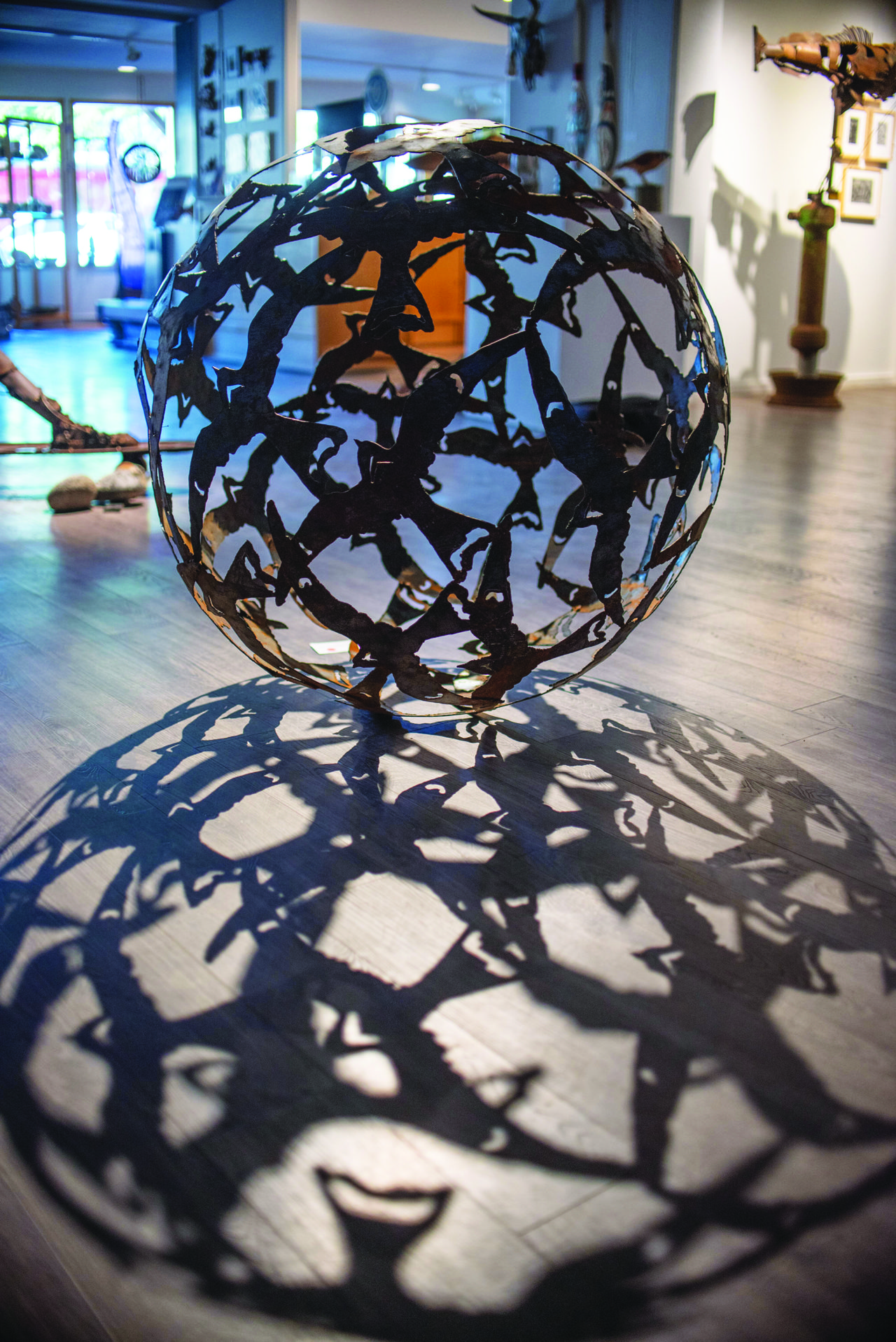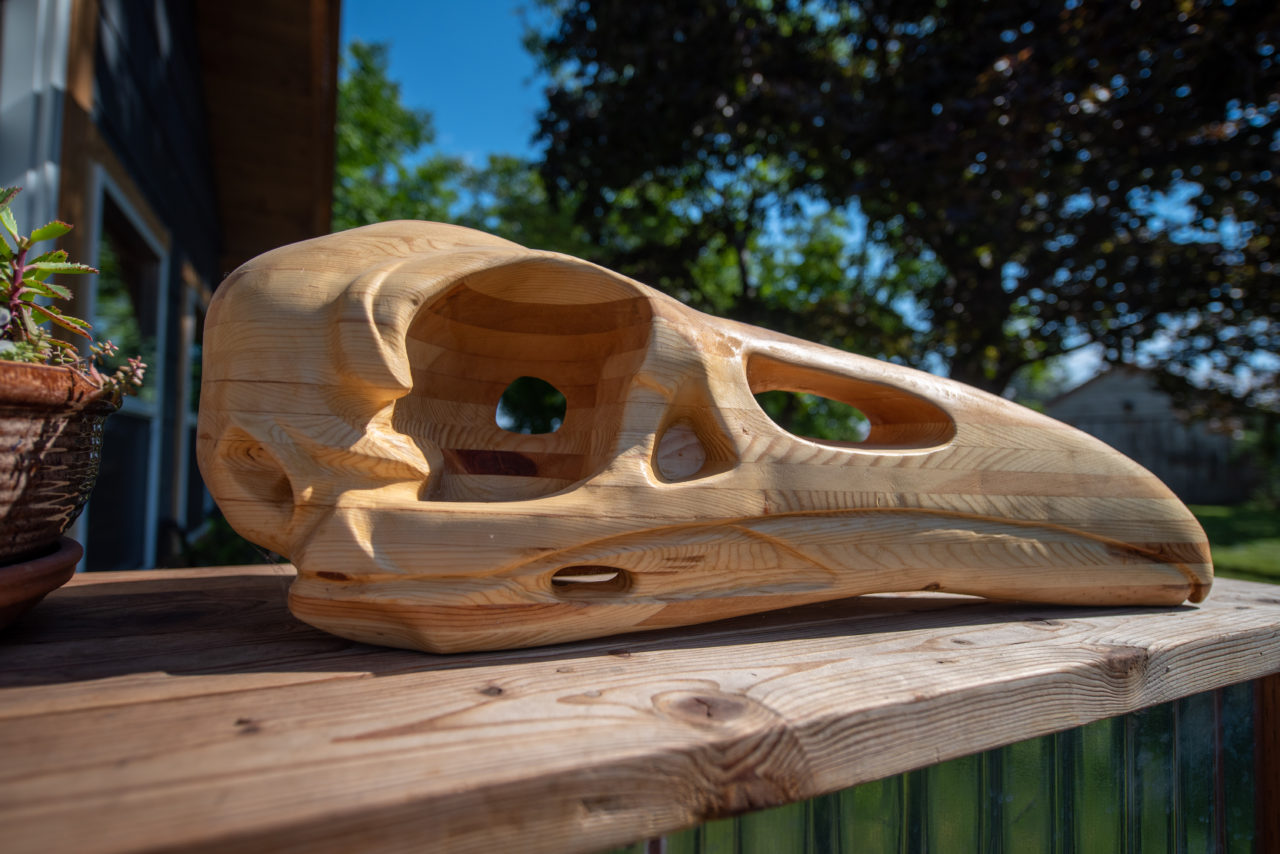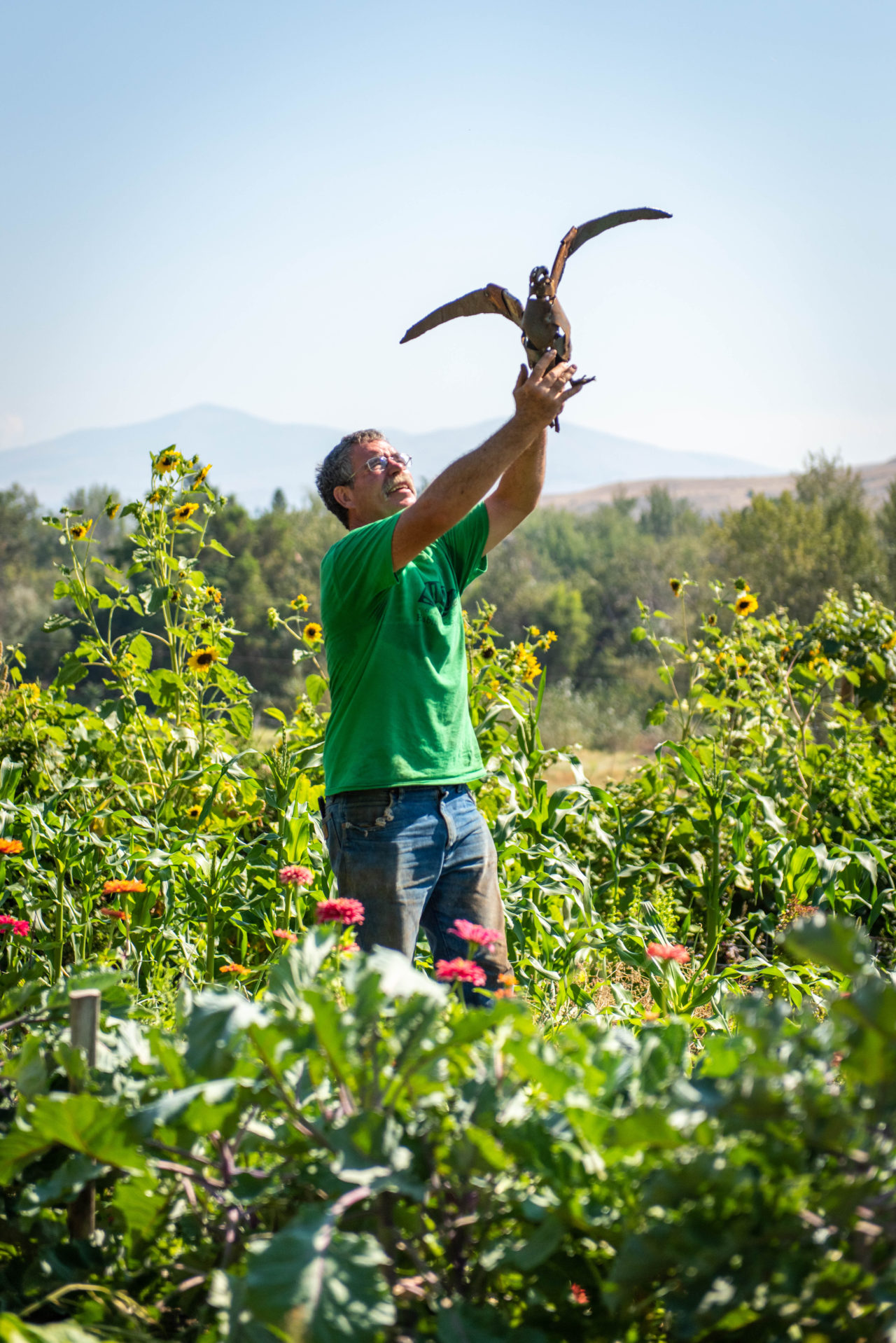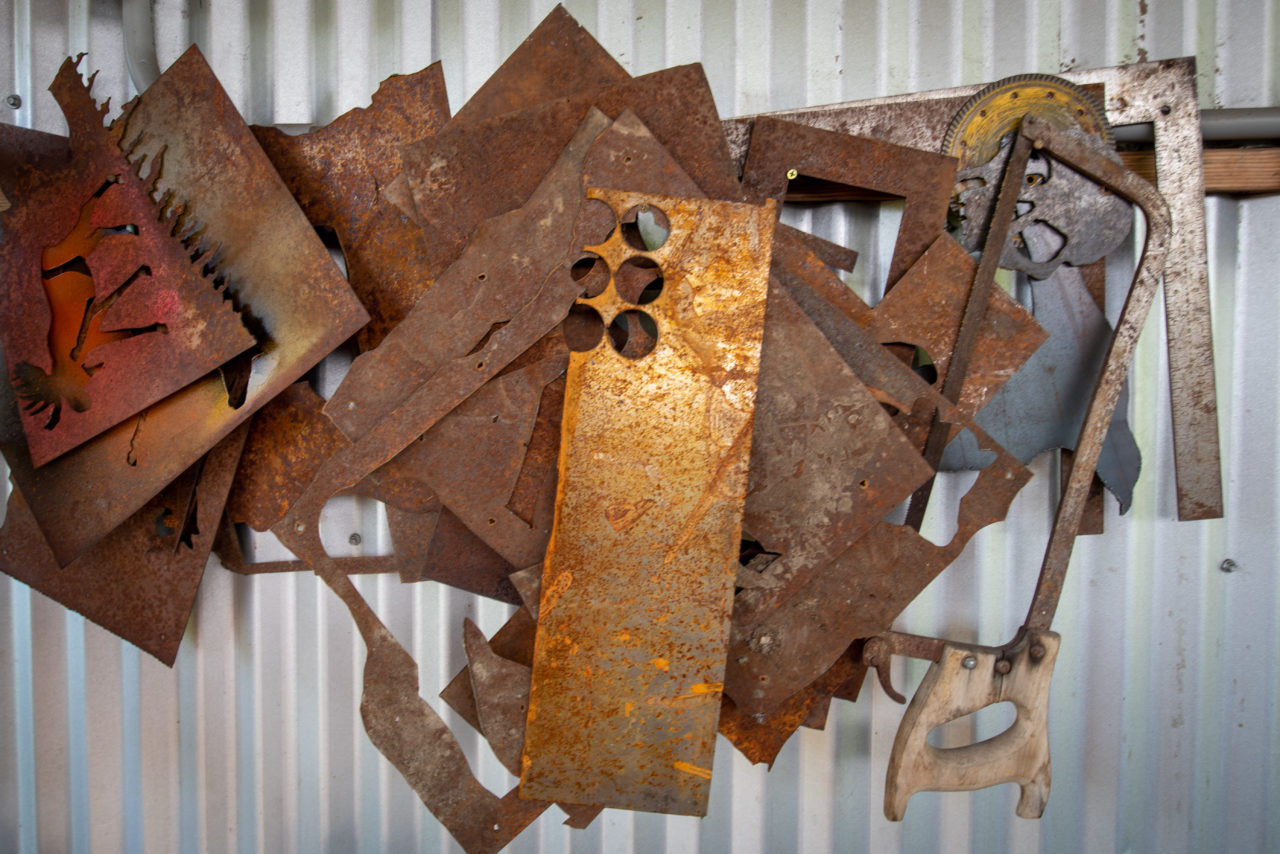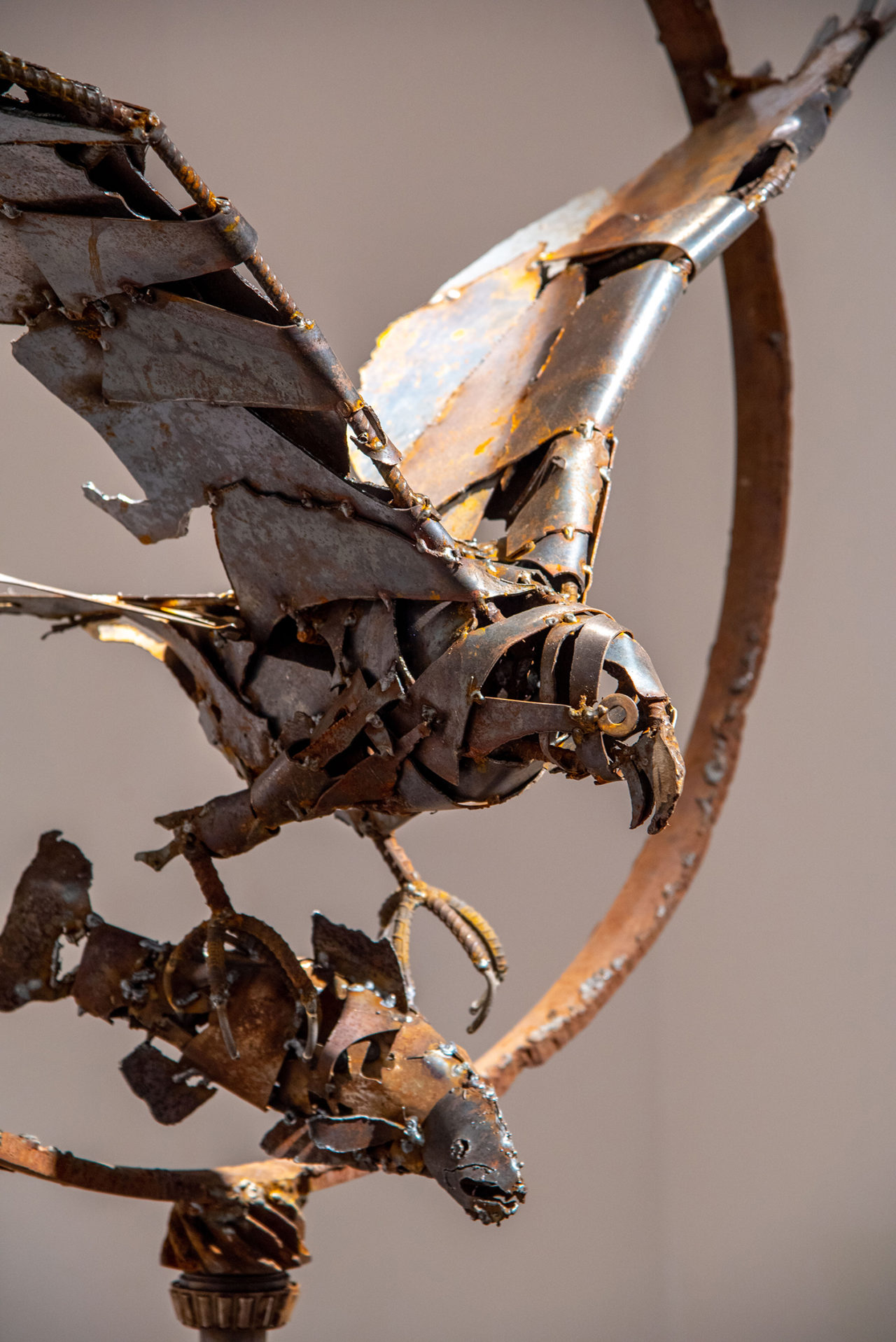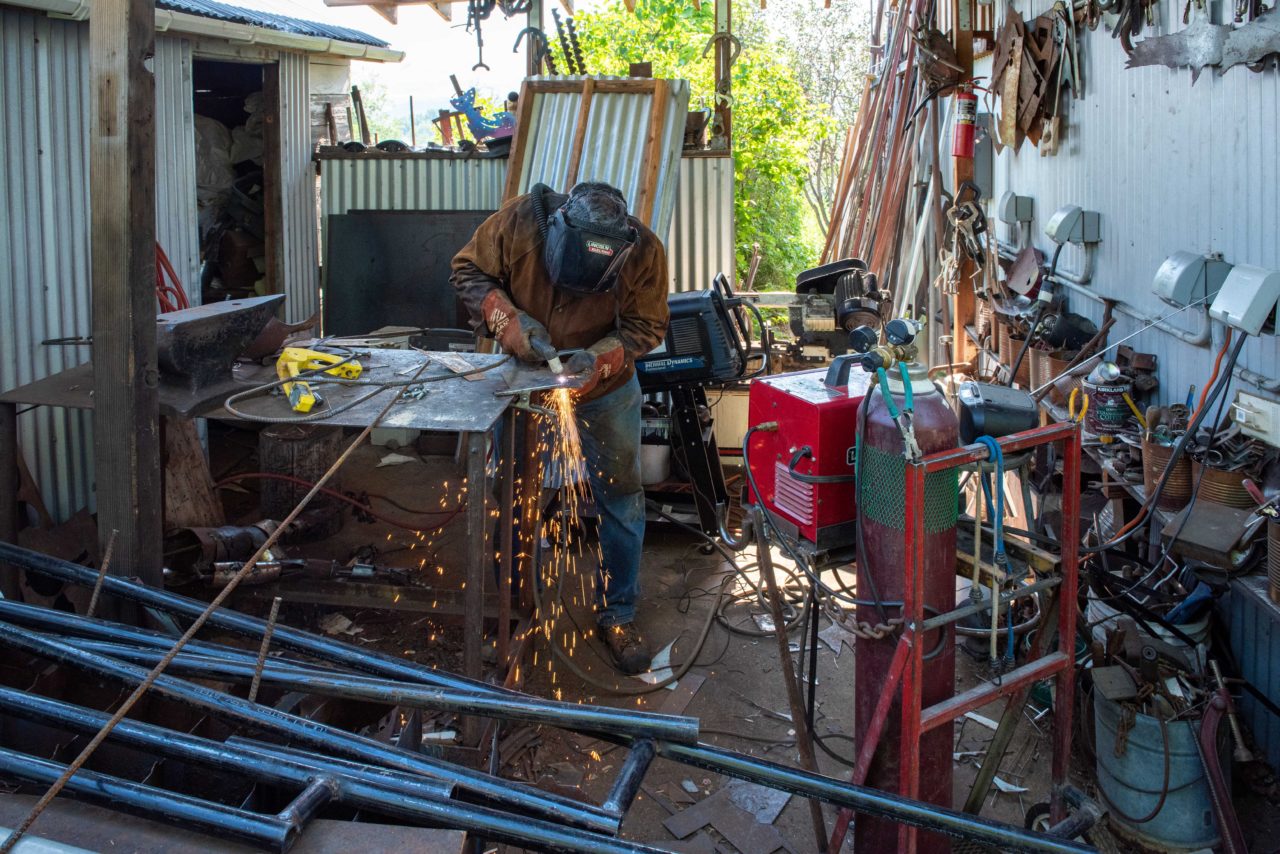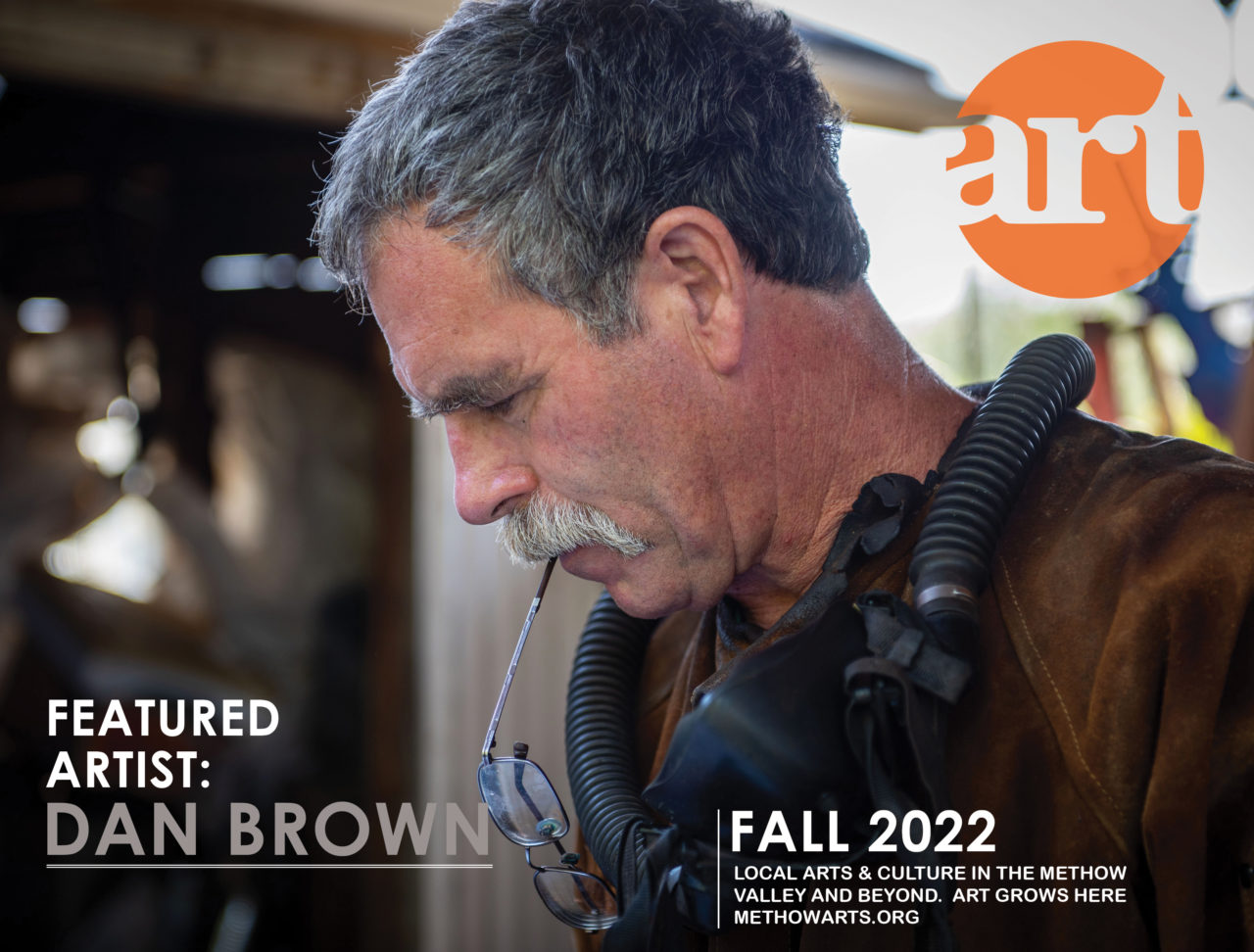
By Marcy Stamper
Photography by Stephen Mitchell
CLICK HERE TO VIEW FULL FALL MAGAZINE
A small-bale hay loader, playground equipment, a scuba tank, ball bearings, and a jack for a Model T – Dan Brown can turn just about anything into a work of art.
Where other people see junk, Brown sees birds, fish, and insects, a base for a table, or even a flying saucer. In his yard outside Okanogan, Brown has a good-sized heap of metal that, to the uninitiated, looks like a tangle of bedsprings, farm equipment, and pipes. But it’s all awaiting its rebirth as sculpture.
Brown pointed to a camshaft from a truck that will become an elegant table support. He always saves rims and wheels because people are so drawn to circles.
“People are nice to me, and call and say, ‘I have some metal. Do you want it?’” Brown said. “I always say ‘yes.’”
Brown tends to remember who gave him a particular castoff, and that memory often becomes the inspiration for the art he makes from it. He had fun with an enormous coffee roaster he inherited from Dan Donohue, co-owner of Blue Star Coffee Roasters in Twisp. Brown recalls Donohue’s story about his trip to San Francisco to pick up the roaster, which was so large that they had to get a permit to close the street so they could transport it.
Brown transformed the roaster into an elegant sculpture of a salmon perched on a massive coffee-cup base. He fashioned the cup from a 1940s-era propane tank and made the cup handle from an old trampoline. He topped the sculpture with a blue star in honor of its origins.
That sculpture, “Early Morning Coffee on the River,” is featured in a special retrospective at The Confluence/Art in Twisp aptly entitled “Happiness Found: Dan Brown and Friends” – aptly, because Brown derives so much joy from making things.
The exhibit features a breathtaking array of sculptures by Brown, from fish to hawks to bells. There are also more abstract pieces, including a stele – a commemorative column made of steel and concrete – and a flock of birds Brown welded together into a lacy sphere.
Although Brown occasionally buys something special when he can’t resist a shape, donations and serendipitous discoveries provide more than enough material and inspiration. The only requirement is that the materials be made of carbon steel or iron so he can weld them together.
Brown, who retired last year after teaching art at Okanogan High School for 28 years, can now devote himself full time to art making. He figures he has at least 20 years to use up his pile of metal. “Some things are so cool that I’m determined to use them,” he said.
Bugs and biology
Brown has always liked to draw but, unlike many artists, he wasn’t one of those kids who was constantly making pictures. He loved the natural world and was more apt to be outside hunting or fishing.
In fact, Brown wanted to be an entomologist. But in college, when he was told he couldn’t study insects until he’d completed years of prerequisites, he got a degree in wildlife biology instead.
Wildlife biology provided an unexpected opportunity for Brown to hone his artistic skills. He did scientific illustrations for Dr. Richard Johnson, who was rewriting his key to the mammals of Washington. Brown created about 80 meticulously detailed ink drawings, primarily of skulls, of everything from shrews to porcupines to bighorn sheep.
In fact, Brown has all his original drawings today because the professor was so thorough that he always wanted to research one more detail for the book and, in the end, it was never published.
After college, Brown couldn’t get hired as a biologist without putting in significant time as a volunteer first. He needed a paying job and didn’t have the luxury to work for free. An uncle who was a dentist offered him a job making crowns, but it took just one day in a windowless room for Brown to know that wasn’t for him.
So Brown became a science teacher. At a small school in Soap Lake, he taught everything from biology to chemistry to math, along with one art class. After five years in that job, he and his wife, Susan, spent two years in Paraguay in the Peace Corps working in environmental education and agroforestry.
On his return to Washington, Brown applied for several teaching jobs – in biology, math, and art – and was hired as the art teacher in Okanogan. He thinks that having decorated his application letter and envelope with illustrations helped impress the hiring committee.
Brown was the perfect teacher because he’s always interested in learning. He took art classes during the summers, and his lesson plans always included a unit in something he didn’t know how to do so that he would learn along with his students.
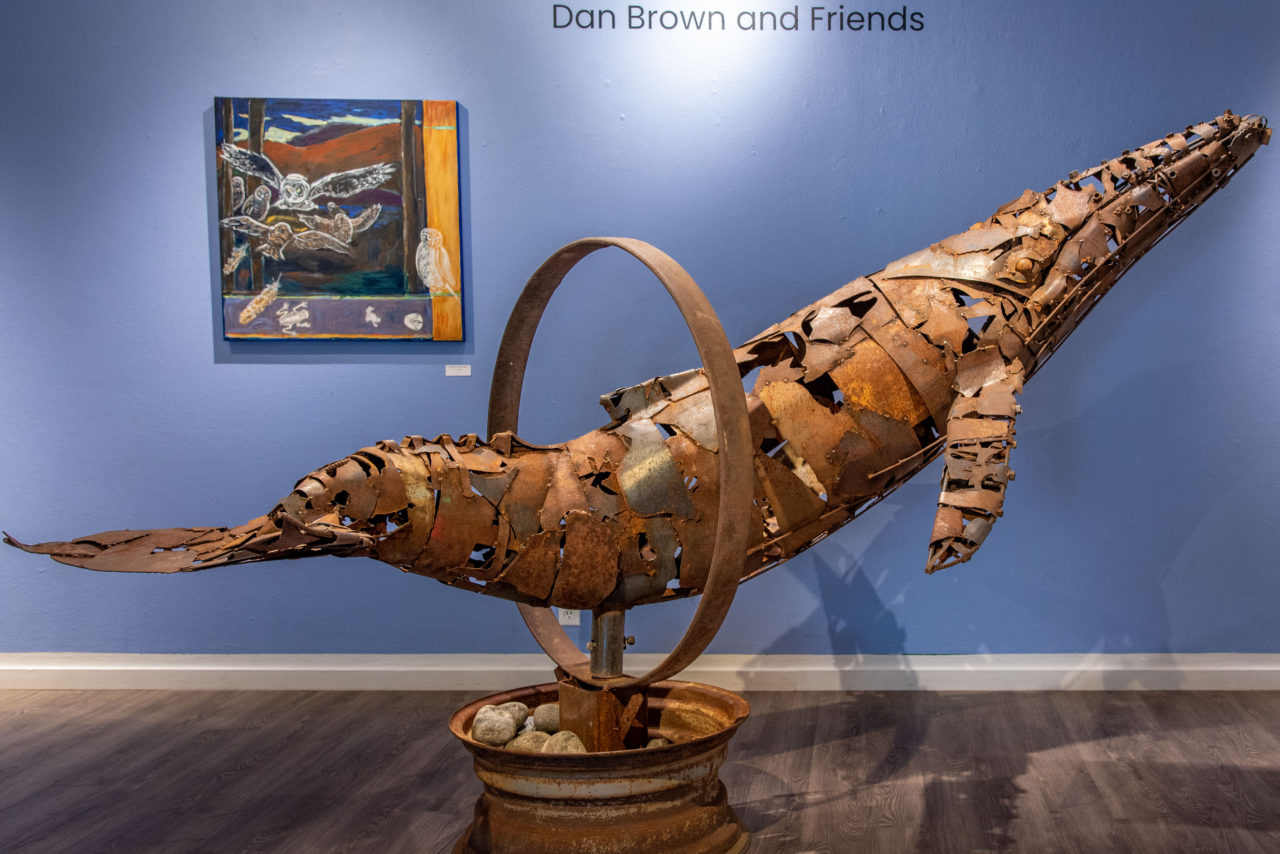
With his heavy school schedule, in the little time he had for his own art Brown did watercolor paintings. He made the rounds of farmers markets and designed t-shirts and posters for local events. He exhibited in local galleries, but there were so many talented painters – and people had limited wall space – that he decided to make sculptures for yards and gardens instead.
Brown hadn’t done any metalwork until one of his students expressed an interest in it. He was immediately attracted to the process and its potential and taught himself additional techniques.
He honed his style over several years, paying attention to what people were attracted to. “Making art is fun – it doesn’t matter what kind of art it is. Something about making things is part of being human,” Brown said. “I’m so fortunate that I came across an art style that people like.”
Because he doesn’t have a shop with adequate ventilation, Brown works outside year-round. Although his outdoor workspace offers protection from the elements, he admits that creating art in the winter is hard. His equipment is pretty basic – he uses a small welder, a plasma cutter and a band saw, an oxyacetylene torch to heat metal so he can bend it, and a good respirator.
Inspiration and whimsy
Brown often starts with an idea for a sculpture, but sometimes a piece of metal in his boneyard provides the inspiration. He enjoys the process of sketching ideas and will make dozens of sketches to develop a concept.
Once he has a sketch he likes, Brown builds the armature for a sculpture by bending rebar into the outline of the animal. He then cuts out small sheets of metal in irregular shapes, which he bends and welds to the armature to create bodies, wings, and heads.
He pointed to a pile on the ground of seemingly random geometric shapes cut out of metal. “This is how I work – this is not messy,” Brown said. As he builds a sculpture, he rummages through the pile for a piece that’s the right shape and size to weld to the form.
He overlaps the metal pieces, but leaves gaps and openings that give his sculptures an intricacy and a kinetic sense of energy. The openings also create a play of light and shadow that changes throughout the day.
Brown has a unique ability to find elegance in rusted metal. Whether it’s a statuesque heron, a leaping salmon, or a whimsical piece of furniture, Brown’s sculptures have a refinement that captures the personality he finds in his subjects. While he especially likes making animals, Brown also creates abstract sculptures, gates, and functional pieces.
His wife, Susan, plays an important role in Brown’s art. “I tend to be messy, and sometimes say an artwork is fine, and Susan makes sure I do things right,” he said. She can see things he doesn’t notice – for example, she once had him change the nose on a wolf three times until he got it right. “She keeps me honest,” he said.
Brown’s wit and personality are an integral part of his work. He loves unusual juxtapositions and is delighted when people pick up on the humor behind one of his creations.
For a while Brown made a series of penguins, but they didn’t sell until he started outfitting the penguins with props, like a lunch pail, a fishing pole, or a necklace made from pasta to adorn a species called a macaroni penguin. He outfitted an old porcelain sink with a lizard for a sculpture he calls “Kitchen Skink.”
A sculpture of a heart, complete with blood vessels made from flexible metal tubing, was exhibited with a request for people to “Tell my heart something good.” Brown included a slot in the heart where people could deposit a slip of paper with their thoughts. “People wrote the nicest things, sometimes for themselves,” he said. There were tributes to loved ones who’d died from a heart attack, reflections on romance, and personal notes to the artist.
Brown’s interest in insects lives on in a series of bugs he makes from aerosol paint cans, which he paints with the distinctive patterns of creatures like sphinx moths and banded alder borers. Each can is outfitted with a pair of antennae.
Brown loves making books and is working on a compendium of his aerosol-can bugs. He’s also created a book of fanciful versions of North American trout. In his imagination, the Mountain Cutthroat trout gets climbing ropes for a ladder and the Kamloops trout has spots made from Froot Loops to give it a sweet flavor that appeals to kids.
Brown often delivers and installs his larger sculptures, which gives him the satisfaction of seeing where his art ends up. He aspires to making something really massive – if he can get a forklift to work on it.
Brown has work in public art collections, including an osprey at the Twisp Ponds. “Jailbirds,” at Sleeping Lady Mountain Resort in Leavenworth, is a sculpture of three ravens perched on a bicycle rack that he repurposed from jail bars from the jail in Okanogan.
Some of Brown’s work makes a statement. He created a piece for a public art installation on the Olympia waterfront called “Follow the Drinking Gourd,” a spherical sculpture of stars he made from old railroad spikes. The title references the way formerly enslaved people relied on the Big Dipper to guide them along the Underground Railroad.
“I am very fortunate to end up doing what I do. I loved being an art teacher and love being an artist,” Brown said. “It really is amazing that other people like what I do enough to buy it. I am grateful that they like my art.”
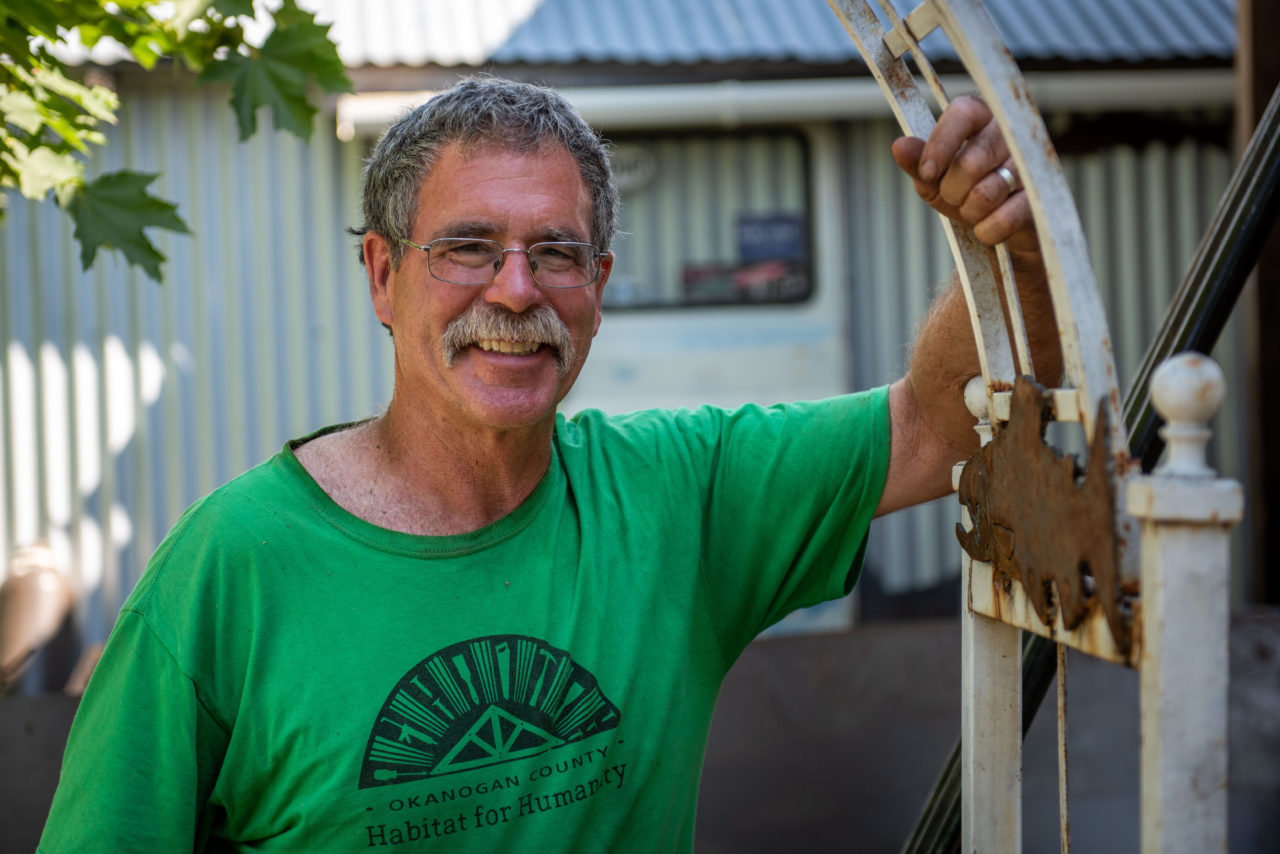
Dan Brown’s work is featured at Methow Arts from early September through mid-November and in “Happiness Found: Dan Brown and Friends” at The Confluence/Art in Twisp through September 17. He also has work at the Winthrop Gallery and at the Twisp Ponds, just outside town on Twisp River Road.
CLICK HERE TO VIEW FULL FALL MAGAZINE
